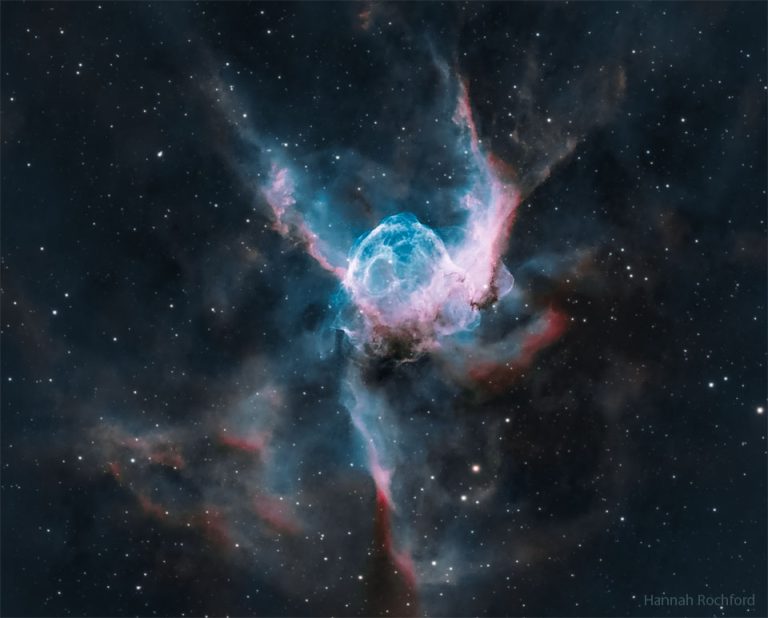沃尔夫-拉叶星124: 恒星风机器
A starfield is shown with a large spherical nebula in the center. The nebula shows a great deal of internal structure. Please see the explanation for more detailed information.
图中显示的是一片星空,中心有一个巨大的球形星云。星云显示出大量的内部结构。有关更多详细信息,请参阅说明。

A starfield is shown with a large spherical nebula in the center. The nebula shows a great deal of internal structure. Please see the explanation for more detailed information.
图中显示的是一片星空,中心有一个巨大的球形星云。星云显示出大量的内部结构。有关更多详细信息,请参阅说明。

A starfield is shown with a unusual textured nebula in the center colored in brown with blue trimmings. Diffuse red nebula appear around the edges. In the center is an opaque brown object. Please see the explanation for more detailed information.
星空中央有一个质地不寻常的星云,呈棕色,蓝色镶边。边缘出现弥漫的红色星云。中央是一个不透明的棕色天体。有关更多详细信息,请参阅说明。

See Explanation. Clicking on the picture will download the highest resolution version available.
请参阅说明。单击图片将下载可用的最高分辨率版本。

请参阅说明。单击图片将下载可用的最高分辨率版本。

2023年5月18日 WR 134 Ring Nebula Image Credit & Copyright: Craig Stocks Explanation: Made with narrowband filters, this cosmic snapshot covers a field of view about the size of the full Moon within the boundaries of the constellation Cygnus. It highlights the bright edge of a ring-like nebula traced by the glow of ionized sulfur, hydrogen, and oxygen gas. Embedded in the region’s interstellar clouds of gas and dust, the complex, glowing arcs are sections of bubbles or shells of material swept up by the wind from Wolf-Rayet star WR 134, brightest star near the center of the frame. Distance estimates put WR 134 about 6,000 light-years away, making the frame over 50 light-years across. Shedding their outer envelopes in powerful stellar winds, massive Wolf-Rayet stars…

2023年3月18日 Wolf-Rayet 124 Image Credit: NASA, ESA, CSA, STScI, Webb ERO Production Team Explanation: Driven by powerful stellar winds, expanding shrouds of gas and dust frame hot, luminous star Wolf-Rayet 124 in this sharp infrared view. The eye-catching 6-spike star pattern is characteristic of stellar images made with the 18 hexagonal mirrors of the James Webb Space Telescope. About 15,000 light-years distant toward the pointed northern constellation Sagitta, WR 124 has over 30 times the mass of the Sun. Produced in a brief and rarely spotted phase of massive star evolution in the Milky Way, this star’s turbulent nebula is nearly 6 light-years across. It heralds WR 124’s impending stellar death in a supernova explosion. Formed in the expanding nebula, dusty interstellar debris that survives…

2022年12月20日 Thor’s Helmet Image Credit & Copyright: Hannah Rochford Explanation: Thor not only has his own day (Thursday), but a helmet in the heavens. Popularly called Thor’s Helmet, NGC 2359 is a hat-shaped cosmic cloud with wing-like appendages. Heroically sized even for a Norse god, Thor’s Helmet is about 30 light-years across. In fact, the cosmic head-covering is more like an interstellar bubble, blown with a fast wind from the bright, massive star near the bubble’s center. Known as a Wolf-Rayet star, the central star is an extremely hot giant thought to be in a brief, pre-supernova stage of evolution. NGC 2359 is located about 15,000 light-years away toward the constellation of the Great Overdog. This remarkably sharp image is a mixed cocktail of data…

2020 March 8 Wolf-Rayet Star 124: Stellar Wind Machine Image Credit: Hubble Legacy Archive, NASA, ESA; Processing & License: Judy Schmidt Explanation: Some stars explode in slow motion. Rare, massive Wolf-Rayet stars are so tumultuous and hot that they are slowly disintegrating right before our telescopes. Glowing gas globs each typically over 30 times more massive than the Earth are being expelled by violent stellar winds. Wolf-Rayet star WR 124, visible near the featured image center spanning six light years across, is thus creating the surrounding nebula known as M1-67. Details of why this star has been slowly blowing itself apart over the past 20,000 years remains a topic of research. WR 124 lies 15,000 light-years away towards the constellation of the Arrow (Sagitta). The…

2020 March 2 Sharpless-308: The Dolphin Nebula Image Credit & Copyright: Chilesope 2, Pleaides Astrophotography Team (Peking U.) Explanation: Blown by fast winds from a hot, massive star, this cosmic bubble is much larger than the dolphin it appears to be. Cataloged as Sharpless 2-308 it lies some 5,200 light-years away toward the constellation of the Big Dog (Canis Major) and covers slightly more of the sky than a Full Moon. That corresponds to a diameter of 60 light-years at its estimated distance. The massive star that created the bubble, a Wolf-Rayet star, is the bright one near the center of the nebula. Wolf-Rayet stars have over 20 times the mass of the Sun and are thought to be in a brief, pre-supernova phase of…